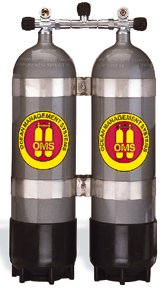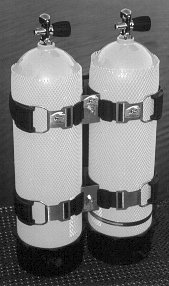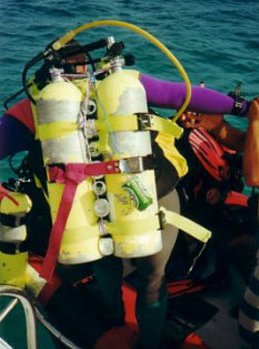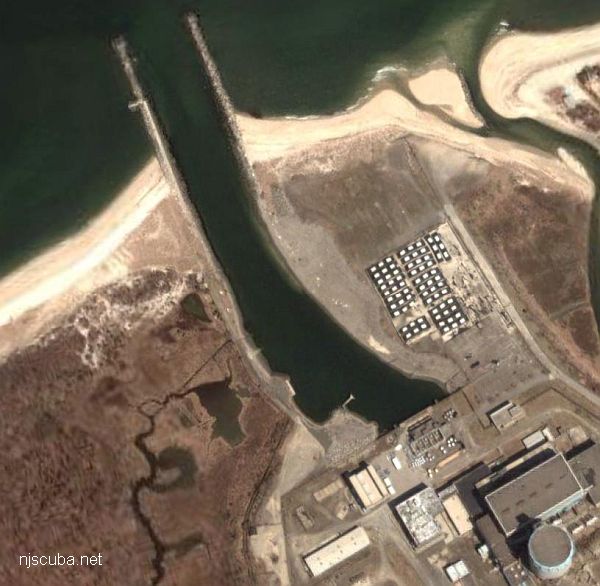Main Tanks & Bands

Scuba tanks are made out of steel or aluminum. Aluminum is cheaper and has somewhat better corrosion resistance, but steel is stronger. The "standard" modern scuba cylinder is the aluminum "80", which actually holds about 77 cubic feet of air at its rated pressure of 3000 psi. This type of tank has probably caught on because for an average-sized person with reasonably good breathing skills, this size is just big enough to cover your allowable no-decompression bottom time and no more. For smaller people, 63 cubic foot aluminum tanks are available, while for larger folks there are choices as big as 120 cuft.
The most common alternative to the aluminum 80 is the steel 72, which holds about 72 cubic feet of air at about 2400 psi. The advantage of a steel tank is in its buoyancy characteristics. An aluminum tank becomes buoyant as it empties, up to +4 lbs., while a steel tank starts out around -3 lbs. and finishes near neutral. This means you can reduce your weighting by this much. ( Honestly, this is not much of an issue with a single tank. ) At the other end of the spectrum, high-pressure aluminum ( 3300 psi ) and steel ( 3500 psi ) tanks are available, but these require special "DIN"-type regulators ( regulator conversion kits are widely available. ) Lower pressure tanks are faster and easier to fill; you may have problems getting a complete fill with high-pressure tanks in some areas. A minor nit with steel tanks is that their negative buoyancy makes them somewhat tipsy in the water, as your tank and suit try to trade places, but you get used to this pretty quickly. With proper maintenance and handling, a steel tank can be expected to far outlast an aluminum one, which offsets the price difference somewhat. There are many 20 or even 30-year-old steel tanks still in service, whereas an aluminum tank could be considered old at ten years.
One thing every diver should carry is a separate reserve air supply. This can be accomplished either with a small pony bottle that has its own separate regulator or by doubling up two full-sized tanks, each with its own regulator. The latter system has the advantage of also doubling your air supply, giving longer bottom times on deeper dives, if you are willing and experienced enough to do some decompression. The advantages of a pony bottle system are lower cost and lighter weight.
There is only one way to set up a single tank, and you learned it in your open-water course, so there is really nothing more to discuss. There are a number of ways to set up double tanks, and each has its pros and cons. The fact that there is simply more to say about doubles than singles does not mean that it is a more valid or superior configuration, just more complicated, and not strictly necessary either.

The methods for doubling up tanks fall into two categories - metal bands that hold the tanks together semi-permanently, and Velcro bands that easily disassemble. Metal bands are often used with an air manifold that connects the two tanks together at

the valves. Without an extra isolation valve on the manifold, the two tanks function as one large one, and redundancy is lost. With an isolation valve, they can be cut off from each other in the event of a regulator or valve failure and function as independent units. The isolation valve itself is a critical failure point, although in practice these are highly reliable. Since these bands do not easily break down, you must carry the entire bulk in one piece whenever moving it around, often an unpleasant proposition. The metal bands attach to your BC by means of bolts.
A more recent development is Velcro doubles bands. By far the best of these that I have seen (and use) comes from AquaExplorers - the Ultimate Velcro Doubles Bands. these consist of a pair of central stainless steel brackets that bolt to your BC, which support two sets of regular Velcro cam-type tank bands. The brackets may be left permanently on the BC, or quickly removed if single-tank use is desired, as for an inlet dive. The tanks may be easily and independently swapped out of the bands, allowing for great flexibility, and any size of tank, including rentals, and even two different sized tanks, may be used. Scenarios include:

Redundant singles - use one tank on the first dive and the second tank on the second dive. ( In practice - use half the air on the first dive, and the remainder on the second. ) Effectively, this gives you a very large pony bottle and spares you the trouble of breaking down your gear between dives.
One-and-a-halfs - use all of one tank and half of the second on the first dive, then swap out the empty tank and do it again on the second dive.
Independent doubles - empty both tanks on the first dive, then swap out both for fresh tanks for the second dive.
If these bands are set up very tightly, they are just as strong as steel bands, and could conceivably be used with a manifold, although this would be asking for trouble. If the tanks ever shifted, the expensive manifold would break. To tell the truth, I have endured many a lecture on the safety and superiority of manifolds over independent tanks, and in the end, every one of them sounded to me more like an argument against manifolds than for them. One thing that is true is that with independent tanks, there is a need to periodically switch regulators in the water, and that simple but conscious gas management is required - it is best to draw down both tanks simultaneously in small increments, say 500 psi, so that in the event of the failure of the more-full tank, the other will not be empty. Manifolded tanks do away with these problems, but also lose the aspects of true redundancy, flexibility, and low cost. Another point in favor of independent doubles over conventional doubles is cost. Isolation manifolds and valves are dreadfully expensive.
A point against any kind of doubles is weight. Even the lightest set of doubled-up 80s is going to tip the scales at almost 100 lbs. with regs installed. This is about as light as it gets. Bigger folks who naturally use more air will want bigger tanks, but then they should be capable of hefting the extra weight. Of course, bigger tanks weigh even more, and that is why I say you should plan ahead for this when selecting your BC and weight system. The use of double tanks also makes a weight-integrated BC desirable, since you will now need to carry enough weight to sink two tanks. This was once the big attraction of steel tanks over aluminum, but if you no longer need to wear an uncomfortable weight belt, the price advantages of aluminum make them more attractive again.
It has been pointed out to me that I seem to be recommending double-tank setups. In fact, I am not. What I am recommending is the ability to flexibly configure your equipment for whatever type of dive you are doing right now - whether it be deep, shallow, long, short, boat, shore, currents, waves, etc. The discussion of temporary doubles bands is motivated by the fact that manifolded doubles are anything but flexible ( and are also ridiculously expensive ) and that it is relatively rare to actually need double tanks for a particular dive.


